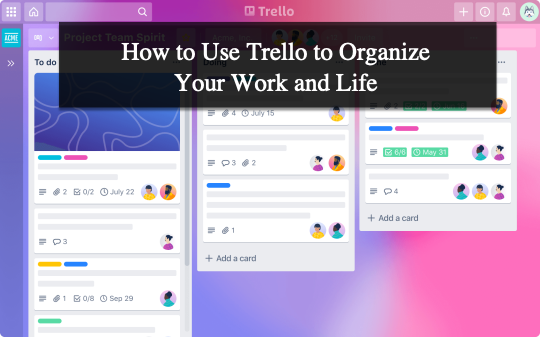
You may be familiar with Trello if you use software to organize your life with to-do lists and calendars.
Trello is my preferred organizational tool for tracking everything from website board meeting agendas to weekly housekeeping tasks. Its boards, lists, and cards offer a customizable and intuitive way to organize my life efficiently.
★ If you use Trello, check out our tool, Bridge24 for Trello, for enhanced reporting and exporting capabilities.
Here are the top three ways I utilize Trello to enhance productivity and stay organized:
Create Separate Work Hubs with Boards
Trello enables users to create boards, similar to a physical board in an office, to pin essential information such as due dates, tasks, and to-do lists. Unlike a physical board, Trello allows the maintenance of multiple boards simultaneously.
I maintain distinct boards for various aspects of my life: one for my career advancement program, another for my website board, and a general board for life management. This separation prevents mixing professional and personal details, avoiding clutter and anxiety. Maintaining different sets of boards for different areas of life or multiple jobs keeps details distinct and organized.
Map Out the Workflow with Lists
Trello lists help me think through and execute workflows and organize tasks. This feature allows for creativity and personalization to suit individual needs.
I organize my lists based on task priority and progress. High-priority tasks are those due soon or requiring significant time, while low-priority tasks have later due dates. Extra tasks are those with no specific due date or minimal time requirements. “In progress” and “done” lists track the status of tasks.
There are various ways to organize lists, such as by project priority, due dates, weekly calendars, or project status. This flexibility allows users to customize their workflow according to their preferences.
Detail Projects and Tasks with Cards
Cards represent individual projects, tasks, or pieces of information within the workflow. For instance, a card labeled “Update the website menu” includes specific details for that task.
Cards can incorporate several features, including due dates, checklists, labels, and attachments. For example, a card might include a checklist of tasks, a due date, and a Google Sheet attachment. This functionality enhances task management and ensures thorough tracking of project components.
Conclusion
Trello is an excellent task management tool with customizable features such as boards, lists, and cards to organize life and work. I hope this overview of how I use Trello inspires you to utilize it for your organizational needs, enhancing your productivity and efficiency.
Leave A Comment